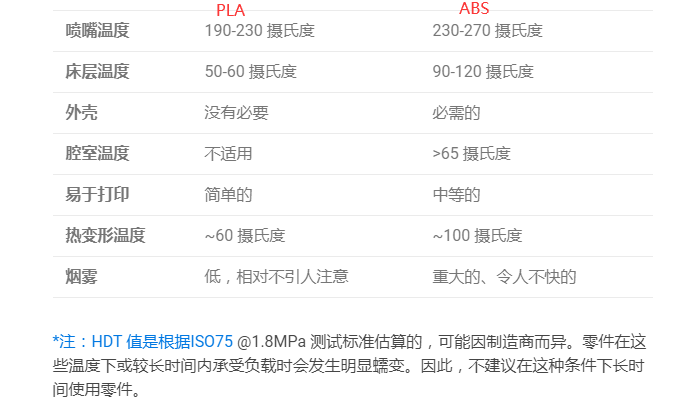3D printing encompasses a variety of technologies, but the most popular among consumers is fused deposition modeling (FDM). Filaments can be made from different materials, but are typically thermoplastic because they melt and resolidify easily.
Among the many types of filaments, the most popular is polylactic acid.(PLA), known for its ease of use and low price. But there are other common materials, such as acrylonitrile butadiene styrene (ABS), a widely used material for injection molding of consumer products.
PLA and ABS are the two most used filaments for FDM 3D printing. Although they are both thermoplastic and look similar, they have many differences. In this article, we will compare these two materials on several different points, including material properties, printing, and price.
A,material properties
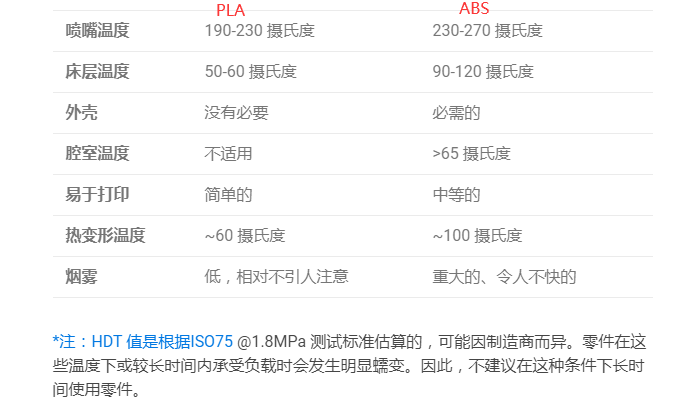

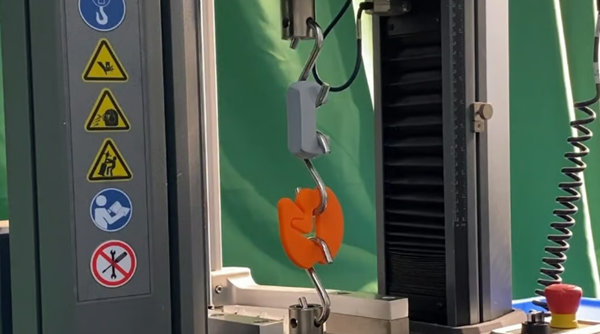

Polymaker Crochet Competition Tests Ultimate Tensile Strength (Source: Polymaker via YouTube)
Let’s take a look firstMaterial properties of PLA and ABS. We will look at their strength, durability, high temperature resistance, post-processing, water permeability and recyclability.
ultimate tensile strength
ultimate tensile strength(UTS) is the maximum stress a material can withstand when stretched or pulled before breaking. It is measured using a tensile testing machine which applies tension to a test sample until it breaks.
According to readily available material datasheets and other tests, for identical load samples printed with the same parameters,The ultimate tensile strength of PLA is higher than that of ABS. That said, it should also be considered that the density of PLA (~1.25 g/cm 3 ) is approximately 20% higher than that of ABS (~1.04 g/cm 3 ). This makes their UTS to weight ratio very similar, although PLA still has a slight advantage.
The degree of adhesion between layers affects the final tensile strength of the material. between the two,ABS is more susceptible to layer adhesion issues than PLA. If printed incorrectly (i.e. insufficient flow and low ambient temperatures), the adhesion of the ABS layers will decrease, thereby reducing the strength of the part, especially when loaded on several layers. However, this will not be a problem when printing ABS on a closed printer with higher ambient temperatures, as this results in excellent layer adhesion.
Shock resistance


DIY impact test bench (Source: My Tech Fun on YouTube)
Impact resistance, also called impact strength, is the ability of a material to withstand impact loads.-The ability of a material to absorb sudden or intense force or impact without breaking. Common testing methods include the Izod impact test and the Charpy notch impact test, which uses a pendulum to strike a notched sample and measure the energy absorbed during fracture. You can even make a DIY impact testing device, like the one used by My Tech Fun.
In terms of impact resistance,ABS has great advantages over PLA. This is not surprising since ABS is known for its extremely high impact resistance, especially among low-cost polymers. PLA is harder and more brittle.
Sustainability
When describing a material, durability refers to its ability to last a long time under designed operating conditions without significant deterioration. We are only talking about UV resistance and chemical resistance here.
UV resistant
AlthoughABS is more UV resistant than PLA, but both materials degrade under UV exposure. You can choose acrylonitrile styrene acrylate (ASA), which is a derivative of ABS and has better UV and weather resistance. It also retains the excellent mechanical properties and high temperature resistance of ABS, but is more expensive than both filaments.
chemical resistance
In terms of chemical resistance,PLA is more susceptible to chemical degradation by various acids and alcohols (and at different concentrations) than ABS. Prusa Research has developed a summary table in which different filaments have been tested under laboratory conditions. You will find that ABS is rated higher than PLA in most cases.
Temperature resistance


PLA slides violently at low temperatures! (Source: rob64 via Reddit)
Resistance to high temperatures is an important aspect to consider for many applications, including machine parts and parts used primarily outdoors. When parts are exposed to high stress levels for prolonged periods, progressive mechanical deformation can be observed. This phenomenon is called“Creep”, temperature is the main factor in material creep.
The ISO75 testing standard lists the thermal deformation temperature, which is the temperature at which the material instantly deforms by 0.25 mm under small loads of 0.45 MPa and 1.8 MPa. At these temperatures, the mechanical properties of the parts will drop significantly and they will become unsuitable for mechanical use.
in this regard,ABS has great advantages over PLA. The thermal deformation temperature of PLA is around 60°C, while that of ABS can reach around 100°C. But be aware that you cannot safely use the parts functionally at these temperatures, especially under load.
The safe operating temperature (no or minimal material creep) is well below the thermal distortion temperature. For example, when aSignificant creep may be observed when Voron ABS components are exposed to temperatures above 70°C for prolonged periods.
ForPLA parts can cause problems when exposed to temperatures above 35°C for prolonged periods. PLA is very heat intolerant. Due to its high creep properties and extremely low resistance to low temperatures, this material is not suitable for use in functional rooms.
Hygroscopic
PLA and ABS are highly hygroscopic and easily absorb moisture from the air. This moisture can deteriorate the material itself, causing excessive warping, bubbles, and poor layer adhesion during the printing process. This results in lower print quality and resistance. ABS is generally more hygroscopic than PLA.
Regardless, it is recommended to store both materials in a non-humid environment and dry them before printing (PLA around 55°C, ABS around 75°C).
food safety


even if you can3D printed chocolate, but that doesn’t mean FDM printed models are food safe! (Source: Cacao Press)
purePure PLA and ABS are non-toxic and food safe. They are widely used and recognized in applications involving food processing and applications. For example, PLA is often used in eco-friendly tableware, while ABS is used in tools such as food containers and cookie cutters. However, products for these applications are often injection molded from pure virgin particles.
3D printing filaments contain additives that can significantly improve material properties and the printing experience, for example by reducing warping without making the cavity too hot. In most cases, these additives make the filament unsuitable for food use. However, some manufacturers offer thread that meets food grade standards.
Besides consumables, there are important hardware considerations related to food safety. Parts of the printer that come into contact with the filament can be dangerous. For example, extruder gears, hot end paths, and nozzles cannot be made from food grade steel. They may have been exposed to non-food consumables or lubricants. Brass nozzles can also wear out, leaving brass residue in the printed part.
There may also be small spaces between layers of FDM parts where bacteria can grow and survive. Without proper reprocessing, these parts are dangerous.
It is therefore not recommended toFDM printed PLA or ABS parts are intended for food applications unless you have thought through and taken steps to avoid any form of contamination.
recyclability


PLA biodegrades efficiently under industrial composting conditions (Source: G. Kale et al. via ResearchGate)
From a recycling point of view,PETG and ABS are recyclable. However, they all fall under Resin Identification Code #7 (“Other”), meaning none of them can be recycled through regular collection. Easily recyclable materials range from #1 to #6, which are the types of plastics typically included in curbside recycling programs.
In most cases, theClass 7 polymers are not cost-effective or impractical to recycle, so they are thrown away. However, there are also recycling services for 3D printed parts, including PLA and ABS materials.
We can also consider biodegradability.PLA is biodegradable and compostable because it is made from materials like corn. However, it requires very specific conditions to fully biodegrade, and it takes years, even decades, to essentially decompose under non-industrial composting conditions. ABS is derived from petroleum and is not biodegradable.
two,3D printing
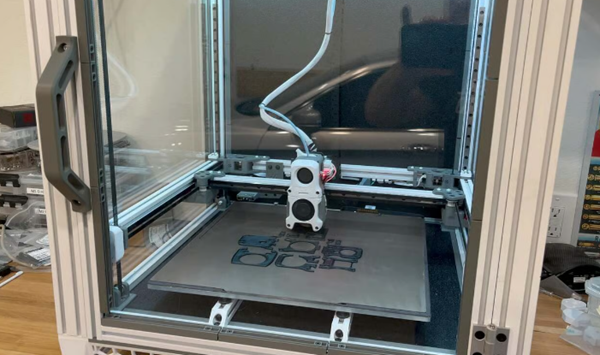

Highly recommended forThe ABS uses a well-sealed housing (Source: Rotorhead8 via Reddit)
PLA and ABS are very different materials, and their printing characteristics are also very different. Let’s see how to print both materials!
temperature
Temperature is an important parameter to consider when printing with both materials.
hot end
The printing temperature of ABS is around 230-270°C, which is much higher than that of PLA, while the printing temperature of PLA is only 190-230°C. As with most filaments, it’s best to lean towards the higher end of this range for better maximum volumetric flow rates and better layer adhesion. However, be careful not to significantly exceed this range, as excessive temperatures can cause excessive stringing, thermal creep, or poor drape. As always, remember to refer to the manufacturer’s recommendations!
Although you can useThe PTFE-lined hot end makes printing with PLA easier, but for versatility and reliability, we always recommend using an all-metal hot end when printing both materials. With an all-metal hot end, you can print multiple materials on the same printer without the need to regularly replace PTFE tubes.
heated bed
Higher heated bed temperature for printingABS components are essential. Not only does this allow for good bonding of the first layer (to reduce warping), but it also helps preheat the passively heated shell (which we’ll discuss below). The temperature should be between 90-120°C, but experienced users tend to set the temperature to 110°C to extend the life of commonly used magnetic build plate magnets.
The bed temperature range of PLA is between 50 and 60°C. It is even possible to print PLA without a heated bed or at temperatures below 50°C, but this depends on other factors such as the type of bed surface and whether an adhesive is used. However, this can cause warping and other problems, which is why it is always recommended to keep the bed temperature between 50 and 60°C.
shell
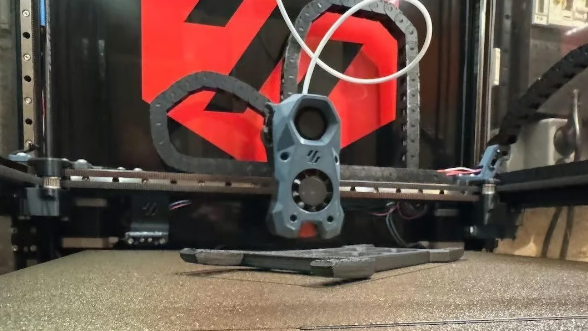

Insufficient room or bed temperature can causeABS deformation (Source: bountybobstrikesback via Reddit)
Enclosures are neither required nor recommended for PLA parts. For starters, this favored material is easier to print than ABS. It adheres well to clean construction boards and rarely warps when the bed temperature is within the recommended range of 50-60°C. PLA also has very good layer adhesion and has negligible shrinkage even without a shell. No enclosure is therefore necessary.
However, if you choose to print with an enclosed printer, ensure that the temperature inside the cavity does not exceed40°C. Since PLA has a very low softening temperature, higher blocking temperatures can cause thermal creep and print failure.
ForFor ABS, the outer casing is crucial for a strong and flawless ABS component. This material is known for its tendency to warp and delaminate due to thermal shrinkage.
The housing keeps printing at a warm temperature, reducing thermal gradients. This prevents parts from cooling too quickly, mitigating warping and delamination issues. It also reduces temperature fluctuations and airflow, which can compromise the printing performance of the material and the strength of the printed part.
High temperature enclosures or actively heated chambers are best suited for high intensities.ABS parts. High ambient temperatures allow the layers to adhere better and relieve internal stresses, thereby significantly increasing the strength of the part. Therefore, it is recommended to set the chamber temperature above 65°C to print high-strength ABS parts. Higher temperatures (80-90°C) are beneficial for strength, but also require more cooling.
cool
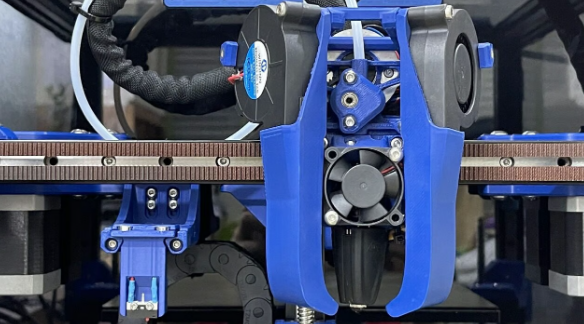

you would likePLA has a better cooling effect (Source: Gedeon Ang via All3DP)
ForFor PLA parts, high cooling is important to avoid defects, overheating, and good bridging and overhang. PLA allows for strong parts and good layer adhesion, even at relatively high cooling settings. Therefore, you need to set the cooling of PLA printing to a higher level.
ABS cooling is more complex; it depends on the cavity temperature during printing. Although cooling can improve draping and bridging properties, cooling ABS too much or too quickly can result in poor layer adhesion and increased warping and delamination. However, for high temperatures in the cavity, this does not pose a problem.
Remember that the warmer the room temperature, the better the cooling effect. If your enclosed space has relatively cool temperatures with passive heating, the cooling setting should also be low.
three,post-processing
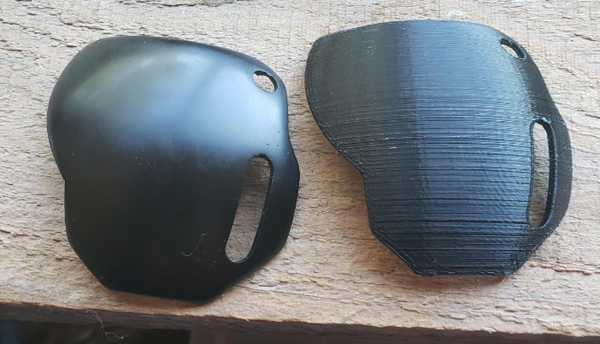

PLA can still be polished to perfection! (Source: AxeCatAwesome on Reddit)
In general,ABS offers more post-processing options than PLA. Users particularly like its ability to be steam smoothed with acetone, which produces parts with very smooth, shiny surfaces, similar to injection molded or machined parts.
Additionally, you can use effective solvents such as acetone orABS glue derivatives) modify or bond ABS parts with relative ease. This is particularly useful for large assemblies or modeling.
PLA is more difficult to dissolve with solvents and only special chemicals can be used to make it smooth. However, ABS and PLA can be easily post-processed by grinding, drilling, tapping, etc., and are easy to paint.
Source: ALL3DP
Daguang focuses on providing solutions such as precision CNC machining services (3-axis, 4-axis, 5-axis machining), CNC milling, 3D printing and rapid prototyping services.
